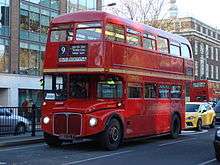Buses in London
The London Bus is a London transportation system used for multiple decades. Considered to be an icon of London, the London Bus operates nights, days, and long-distances on many different routes and lines. The main image of a London Bus is an arched, double-decker, red-painted bus which can carry a large number of passengers.
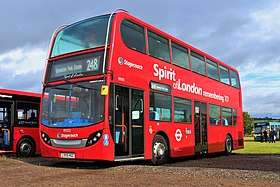
History
| Dates | Organisation | Overseen by |
|---|---|---|
| 1933–1947 | London Passenger Transport Board | London County Council |
| 1948–1962 | London Transport Executive | British Transport Commission |
| 1963–1969 | London Transport Board | Minister of Transport |
| 1970–1984 | London Transport Executive (Greater London only) | Greater London Council |
| London Country Bus Services (Green Line only) | National Bus Company | |
| 1984–2000 | London Regional Transport | Secretary of State for Transport |
| 2000– | Transport for London | Mayor of London |
Organisation
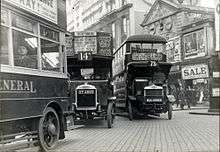
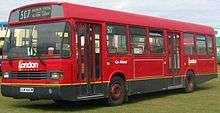
Buses have been used on the streets of London since 1829, when George Shillibeer started operating his horse-drawn omnibus service from Paddington to the City. In 1850 Thomas Tilling started horse bus services,[1] and in 1855 the London General Omnibus Company (LGOC) was founded to amalgamate and regulate the horse-drawn omnibus services then operating in London.[2]
LGOC began using motor omnibuses in 1902, and manufactured them itself from 1909. In 1904 Thomas Tilling started its first motor bus service. The last LGOC horse-drawn bus ran on 25 October 1911, although independent operators used them until 1914.[3]
In 1909 Thomas Tilling and LGOC entered into an agreement to pool their resources. The agreement restricted the expansion of Thomas Tilling in London, and allowed the LGOC to lead an amalgamation of most of London's bus services. However, also in 1909 Thomas Clarkson started the National Steam Car Company to run steam buses in London in competition with the LGOC. In 1919 the National company reached agreement with the LGOC to withdraw from bus operation in London, and steam bus services ceased later that year.[4]
LPTB to LRT



In 1912 the Underground Group, which at that time owned most of the London Underground, bought the LGOC. In 1933 the LGOC, along with the rest of the Underground Group, became part of the new London Passenger Transport Board. The name London General was replaced by London Transport, which became synonymous with the red London bus.[5]
Bus numbers were first used in 1906. When the independent firms started in 1922, they used General route numbers, along with suffixes from the alphabet to denote branch routes. In 1924, under the London Traffic Act, the Metropolitan Police was given the authority of allocating route numbers, which all buses had to carry. This ultimately led to chaos and in the London Passenger Transport Act of 1933 the powers of allocating route numbers was taken away from the police and handed once again to professional busmen.[6] Suffixes were gradually abolished over the decades, the last such route in London being the 77A, which became the 87 in June 2006.
The LPTB, under Lord Ashfield, assumed responsibility for all bus services in the London Passenger Transport Area, an area with a radius of about 30 miles of Central London. This included the London General country buses (later to be London Transport's green buses), Green Line Coaches and the services of several Tilling Group and independent companies.
London buses continued to operate under the London Transport name from 1933 to 2000, although the political management of transport services changed several times. The LPTB oversaw transport from 1933 to 1947 until it was nationalised and became the London Transport Executive (1948 to 1962). The responsible authority for London Transport was then successively the London Transport Board (1963 to 1969), the Greater London Council (1970 to 1984) and London Regional Transport (1984 to 2000).
However, in 1969, a new law transferred the green country services, outside the area of the Greater London Council, to the recently formed National Bus Company. Trading under the name London Country, the green buses and Green Line Coaches became the responsibility of a new NBC subsidiary, London Country Bus Services, on 1 January 1970.
A former network of express buses operated by London Transport in Central London was the Red Arrows. The routes, all numbered in the 500s, ran from main line stations to various locations in the West End and City. They were introduced in 1966 and expanded in 1968, but in the 1990s they were gradually phased out and only two former routes, 507 and 521, remain.[7]
In 1974, Jill Viner became the first female bus driver for London Transport.[8][9]
In 1979, the operation of London's buses under the GLC was divided among eight areas or districts:
| District | Area | Logo (positioned above LT roundel) |
|---|---|---|
| Abbey | West central | Coronet |
| Cardinal | West and Southwest | Bust of Thomas Wolsey |
| Forest | East and Northeast (after Epping Forest) | Squirrel |
| Leaside | North (after River Lea) | Swan |
| Selkent | Southeast | Hops |
| Tower | East central | White Tower |
| Wandle | South (after River Wandle) | Water wheel |
| Watling | Northwest | Bust of Roman soldier[10] |
The districts were later reorganised and reduced to six (with the abolition of Tower and Watling), and, following the Transport Act of 1985, were done away with in 1989 with privatisation imminent.
Privatisation
In the 1980s the government of Margaret Thatcher decided to privatise the bus operating industry in the Great Britain. At the time, local bus transport was dominated by London Transport in London, and in other major cities by large municipally owned operators, as well as by the government-owned National Bus Company and Scottish Bus Group elsewhere. The Transport Act 1985 brought about bus deregulation throughout Great Britain which opened up local bus operation to private operators and required municipal companies to operate independently of local government on a commercial basis.[11]
In London a completely different model was used from the rest of the country; the Transport Act brought about the privatisation of London bus services, which required an arms-length subsidiary company of London Transport called London Buses to be set up with the remit to contract out the operation of services, but to determine service levels, routes, frequencies and fares within the public sector.[12]
This regime is still in place today, and bus operations in London must be put out to competitive tendering so that routes are operated by a number of private companies. In 2000, as part of the formation of the new Greater London Authority, the ownership of London Buses moved from the central (UK) government-controlled London Regional Transport to the Mayor of London's transport organisation, Transport for London (TfL).[12]
Vehicles
_%26_RM54_(LDS_279A)%2C_Whitehall%2C_route_159%2C_9_December_2005.jpg)
From the early days of motor bus operation by the London General Omnibus Company (LGOC) in the 1900s (decade) until the 1960s, London went its own way, designing its own vehicles specially for London use rather than using the bus manufacturers' standard products used elsewhere. The Associated Equipment Company (AEC) was created as a subsidiary of the LGOC in 1912 to build buses and other equipment for its parent company, and continued in the ownership of LGOC and its successors until 1962. Many of London's local service buses over this period were built by AEC, although other manufacturers also built buses to London designs, or modified their own designs for use in London.[3]
The last bus specifically designed for London was the AEC Routemaster, built between 1956 and 1968. Since then, buses built for London's local services have all been variants of models built for general use elsewhere, although bus manufacturers would routinely offer a 'London specification' to meet specific London requirements. Some manufacturers even went so far as to build new models with London in mind such as the Daimler Fleetline and Leyland Titan.
London did see the introduction of several of the newly emerging minibus and midibus models in the 1980s and 1990s, in a bid to up the frequency on routes, although the use of these buses dropped off to the level of niche operation on routes not suitable for full size buses.
With the move to tendered contracts for TfL routes, the 'London specification' was further enforced as being part of tender proposals, invariably specifying new buses. The major difference for London is the usage of dual doors on central routes.
London was one of the earliest major users of low-floor buses. From 2000, the mainstay of fleet, double-decker buses, were augmented with a fleet of articulated buses, rising to a peak fleet size of 393 Mercedes-Benz Citaros.[13] These were introduced to help replace the AEC Routemaster, as well as to cope with an increased capacity.[14] A small fleet of hybrid buses was also introduced.[15]
New Routemaster and bendy bus withdrawal
In the 2008 London mayoral election campaign, prospective mayor Boris Johnson made several commitments to change the London Buses vehicle policy, namely to introduce a new Routemaster, and remove the bendy buses. Johnson was elected to office on 4 May 2008, and on 4 July 2008 Transport for London announced the New Bus for London Competition,[16] in which conceptual and detailed design proposals would be sought for a new hybrid Routemaster, with development of a design that could be put into production hoped for completion by 2012 (the expected date of the next mayoral election).[13]
In August 2008, the London Transport Commissioner Peter Hendy announced that the withdrawal of the bendy buses would take place, starting in 2009. So as to reduce additional costs to TfL, the buses would be withdrawn as their 5-year operating contracts came up for renewal, with the replacement types being decided by operators. Options for replacement would not preclude such measures as tri-axle buses. However, research has indicated that removing articulated vehicles may not be without cost; London Travel Watch undertook a study in September 2008 which found that to replace articulated vehicles on three bus routes, and maintain overall route capacity, would cost an additional £12.6m per annum, due to the additional vehicles necessitated.[17]
On 7 December 2008 Boris Johnson appeared as the "Star In a Reasonably Priced Car" on BBC2's Top Gear in which Jeremy Clarkson questioned him about his plans to withdraw bendy buses, which, as he pointed out, Johnson had announced he planned to do many months prior to this and asked when he actually planned to put this into practice, to which Johnson replied they would be off the road "by around 2010".
The first buses to be withdrawn would be the Red Arrow fleet on routes 507 and 521 (although the latter route requires single deckers as it runs through the Strand Underpass), in May 2009.[18] The last were withdrawn on 9 December 2011.[19]
In May 2010 Mayor of London Boris Johnson unveiled the design of the New Routemaster, the proposed replacement for the Routemaster as an iconic standard bus for exclusive use in London.[20] The buses, designed by Heatherwick Studio and built by Wrightbus[21] feature two staircases, three doors and an open platform allowing passengers to hop on and off, and commenced operating in 2012.
In December 2011 the British car magazine Autocar road-tested the New Routemaster. It said it had "brilliant economy and an interior to die for. The best in public transport".[22] It rated it ahead of the Wright Gemini Hybrid 2 , Mercedes-Benz Citaro and AEC Routemaster.
However, in December 2016 the new Mayor of London Sadiq Khan decided that no more orders would be placed for the bus after only 1,000 of Boris Johnson's envisaged fleet of 2,000 had been procured.[23] In 2020 Transport for London announced that the New Routemasters would be converted so passengers only enter by the front door, with the middle and rear doors becoming exit-only. This was done to reduce fare evasion, which had been double that of other London buses.[24]
Operation
Local buses
 | A representation of the standard London bus stop (although completely fictional in the place names, and route numbers)—yellow squares mean "buy tickets before boarding"; blue squares denote a night bus; the "S" at the top of the pole identifies a particular bus stand at a location with many stands |
Most local buses within London form a network managed by London Buses, an arm of Transport for London. Services are operated by private sector companies under contract to London Buses. With the introduction of the London congestion charge in central London and because at peak times the Underground is operating at maximum capacity, many bus service improvements have been undertaken, and central bus services are currently enjoying something of a resurgence.[12]
Although the rear-entrance double-deck AEC Routemaster is the archetypal London bus, their numbers have dwindled quite quickly owing to their age (the oldest are now more than 60 years old), their inability to accept wheelchairs or pushchairs, and their requirement for a two-person crew. As described below, Routemasters are now restricted to one heritage route.[25]
All other local bus services are now operated by modern low-floor buses, which may be single-deck or double-deck. Most buses operating in London have two sets of doors, and passengers board the bus using the front door and alight using the rear door, whilst some buses on less busy routes have only one door. All these buses conform to the Disability discrimination act, and can accept passengers in wheelchairs and other mobility impaired passengers.
Some local bus routes in the outer areas of London cross the London boundary. London Buses services that cross the boundary have standard red buses, and charge London fares, at least within the boundary. Buses from outside London that cross into London are in their operators' own colour schemes, and may not accept the London fares even within the boundary.
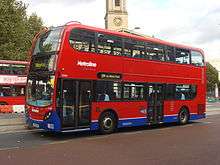 A Metroline Alexander Dennis Enviro400 on route 139.
A Metroline Alexander Dennis Enviro400 on route 139.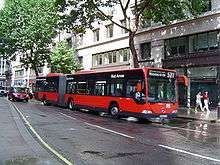 A London General Mercedes-Benz Citaro articulated bus on route 521 operated by London General (withdrawn in 2009).
A London General Mercedes-Benz Citaro articulated bus on route 521 operated by London General (withdrawn in 2009).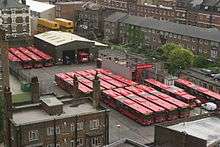

Because the operating contracts for local buses in London are subject to a system of competitive tender, a wide range of companies now operate bus routes across London. Many services have been contracted out to leading transport groups such as Abellio, Arriva, ComfortDelGro, Go-Ahead Group, RATP Group, Stagecoach and Transit Systems. Connex, FirstGroup, National Express and Transdev previously operated services in London.[26][27][28]
Privately run bus services may also be operated independently of the regulated London bus network, but still require a permit from TfL. This permit applies to any service which has a stop in London and another within 15 miles of Greater London, such as commuter coaches, school buses and supermarket shuttle buses.[29]
| Company | Routes | Service area |
Parent company |
|---|---|---|---|
| Abellio London | London & Surrey | Abellio | |
| Abellio Surrey | London & Surrey | Abellio | |
| Arriva London | London | Arriva | |
| Carousel Buses | Buckinghamshire | Go-Ahead Group | |
| CT Plus | Greater London | HCT Group | |
| First Berkshire & The Thames Valley | Berkshire | FirstGroup | |
| Go-Ahead London | London | Go-Ahead Group | |
| Green Line Coaches | Express services to Berkshire & Hertfordshire | Arriva | |
| London Sovereign | North London | RATP Group | |
| London United | West & Central London | RATP Group | |
| Metrobus | South and South East London, and parts of Surrey, Kent, West and East Sussex. | Go-Ahead Group | |
| Metroline | North & West London | ComfortDelGro | |
| Quality Line | South London & Surrey | RATP Group | |
| Stagecoach London | South and East London | Stagecoach Group | |
| Sullivan Buses | Hertfordshire & North London | - | |
| Tower Transit | East, West & Central London | Transit Systems | |
| Uno | Hertfordshire & North London | University of Hertfordshire |
Night buses
Night buses began running as early as 1913, and they form part of the London Buses network. For many years until 1961, the night routes were numbered from around 280 to 299. But the imminent withdrawal of trolleybuses meant that numbers between 1 and 299 were in short supply. The 280+ route numbers were freed by giving night bus routes a prefix N for the first time. For example, while route 9 travels from Aldwych to Hammersmith, route N9 continues a further 16 miles (26 km) from Hammersmith to Heathrow Airport Terminal 5.
There are also 24-hour routes, which run throughout the day and night. These do not have distinguishing numbers. Some of these only run at night during weekends, whereas others run throughout the week.
Heritage routes
The rear-entrance double-deck AEC Routemaster has been withdrawn from all regular service routes, a small fleet is retained to operate on Heritage route 15. Route 9H was withdrawn on 26 July 2014.[30][25][31]
AEC Routemaster buses are not accessible to passengers in wheelchairs and other mobility impaired passengers. Because of this, the heritage route is operated as a short-working of a regular service route bearing the same route number, thus ensuring that passengers unable to board the heritage buses are offered equivalent alternative transport arrangements.[30]
Tour buses

A common sight in central London are tour buses, the majority being open-top buses. These are double-decker buses with a fully or partially open upper deck, which provide tourist services with either live or recorded commentary. Most of these services allow passengers to embark and disembark at any of the company's stops, continuing their journey on a later bus.
There are several competing operators of such services which do not form part of the London Buses network and do not issue or accept London Buses tickets, although at least one paints its buses in the same red as London's local buses.
Other tours use coaches and generally need to be booked in advance through travel agents.
Long distance coaches
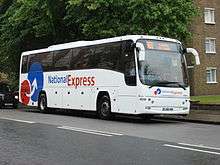
Long-distance coaches link London with the rest of the United Kingdom and with other cities across the European mainland. Many domestic services are run by National Express, with international services mainly provided by Flixbus and Eurolines. National Express' predominantly white vehicles are common on the roads of central London, on their way to and from their terminus at Victoria Coach Station.
In 2006, competition for long distance traffic was introduced by Megabus, a subsidiary of the large UK bus operating company Stagecoach. This company operates cheap services aimed at students and the like, which must be booked in advance on the internet.
Other coach services link London to medium-distance destinations, and unlike National Express or Megabus provide walk-on fares. Good examples of this are the Green Line services to the Home Counties, mainly operated by Arriva, the service to the city of Oxford, where Stagecoach's frequent Oxford Tube service competes with Go-Ahead's similar Oxford Express service, and the many commuter services to medium-distance destinations operated by individual coach companies during peak times.
Airport buses
National Express is also the principal airport bus operator, serving Heathrow, Gatwick and Stansted with its National Express Airport brand. Unlike their longer distance cousins, these are walk-on services, which serve stops throughout central London rather than running to Victoria Coach Station.
London City Airport used to provide express shuttle bus services to connect the airport to rail and underground stations at Canning Town, Canary Wharf and Liverpool Street. These operated at a premium fare (compared with the parallel but slower London Buses services) but did not survive the extension of the Docklands Light Railway to the airport in late 2005.
Electric Buses
London's electric bus fleet is the largest in Europe. In September 2019 London had over 200 electric buses, with a further 78 electric double-deck buses due to enter service in 2020.[32]
Major accidents
- 13 June 1957: RTL 780, operating on route 7 collided with a queue of people at a bus stop in Oxford Street, resulting in eight deaths. The driver had collapsed with heat exhaustion.[33]
- 31 October 2019: A major RTC involving the route R11, route 358 and a car in Orpington, with one of the bus drivers losing his life.
Terrorist incidents
- 18 February 1996: An explosive device detonated prematurely on a route 171 Catford to Holborn double-decker bus, operated by London Central, in Aldwych. The bomb killed Edward O'Brien, the IRA terrorist transporting the device, and injuring eight others including the driver. The force ripped the bus apart, destroying its front.[34]
- 7 July 2005: An explosion occurred as part of a coordinated attack on London on a route 30 Hackney Wick to Marble Arch double-decker bus, operated by Stagecoach London, in Tavistock Square. The force ripped the roof off the top deck and destroyed the back of the bus, killing thirteen passengers and the suicide bomber.[35]
- 21 July 2005: A suicide bomber attempted to explode a bomb as part of a second coordinated attack on London on a route 26 Waterloo station to Hackney Wick double-decker bus, operated by Stagecoach Group, in Bethnal Green. The device failed to detonate properly and there were no injuries.[36]
Media
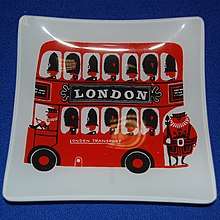
A revamped London bus has been used to promote the work of British artist Sir Peter Blake. An anthropomorphic Routemaster named Topper Deckington III is a fictional character in the Pixar movie Cars 2.
Facts and figures
Note that these figures only take Transport for London services into consideration, and exclude school and other bus services.
Route 25, running between Holborn Circus and Ilford, is the busiest bus route. The service carried over 19 million passengers in 2015/16. The next busiest routes (over 10 million) are: 18, 29, 149, 207, 83, 38, 5, 86, 140, 279, 73, 243, 109, 43, and 36.[37]
Route U9 has the highest mean observed speed of daytime routes, at 18.8 mph. The slowest was 15H at 3.8 mph.[38]
Route X26, running from Croydon to Heathrow Airport, is the longest daytime route at 24 miles. The next longest are routes 166, 358 and 465 (all 17 miles), 111 and 246 (16 miles) and 492 (15 miles).[39]
References
- Thomas Tilling by Peter Gould
- "From omnibus to ecobus, 1829-1850". London Transport Museum. Archived from the original on 9 June 2007. Retrieved 3 July 2007.
- "From omnibus to ecobus, 1901-1913, 3rd page". London Transport Museum. Archived from the original on 30 June 2007. Retrieved 3 July 2007.
- "The Steam Bus 1833-1923 by Peter Gould". Archived from the original on 12 October 2017. Retrieved 18 April 2008.
- "From omnibus to ecobus, 1919-1938, 3rd page". London Transport Museum. Archived from the original on 8 June 2007. Retrieved 3 July 2007.
- Marshall, Prince (1972). Wheels of London. The Sunday Times Magazine. pp. 55–56. ISBN 0-7230-0068-9.
- Marshall, Prince (1972). Wheels of London. The Sunday Times Magazine. p. 114. ISBN 0-7230-0068-9.
- https://www.standard.co.uk/news/transport/the-incredible-women-who-changed-the-face-of-londons-famous-transport-network-a3784931.html
- https://www.youtube.com/watch?v=bci3pyiQz2s
- "London Transport - Local Bus Maps". eplates.info. Retrieved 26 August 2013.
- Parker, David (2009). The official history of privatisation. London: Routledge. p. 232. ISBN 9780203881521.
- "History". Transport for London. Retrieved 3 July 2007.
- Buses Magazine, August 2008 issue, page 5, Ian Allan Publishing
- http://news.bbc.co.uk/1/hi/england/1587406.stm
- "Hybrid buses". Transport for London. Archived from the original on 15 November 2010.
- "Archived copy". Archived from the original on 4 August 2008. Retrieved 4 August 2008.CS1 maint: archived copy as title (link)
- "Consultation on Articulated Bus Routes 38, 507 and 521 (sec. 4.8.1)". London Travel Watch. Archived from the original on 4 March 2009. Retrieved 30 September 2008.
- The beginning of the end for the bendy bus Mayor of London 5 December 2008
- Bendy bus makes final journey for Transport for London BBC News 10 November 2011
- Return of the Routemaster: Boris Johnson unveils new version of classic double-decker bus that lets you hop on and off
- £7.8m London bus contract for Ballymena firm
- New Bus for London driven
- https://www.theguardian.com/uk-news/2016/dec/31/boris-bus-london-transport-sadiq-khan-end
- Topham, Gwyn (10 January 2020). "Fare-dodging forces closure of rear doors on New Routemaster bus". The Guardian. Retrieved 11 January 2020.
- "End of the road for an icon". BBC. 20 May 2004. Retrieved 4 July 2007.
- "The French connection: What's a picture of the River Seine doing on our iconic London buses?". Daily Mail. 25 April 2011. Retrieved 11 April 2013.
- Brummer, Alex (2012). "7. the Export of Transport". Britain for Sale: British Companies in Foreign Hands. Random House. ISBN 1448136814.
- Macalister, Terry; Milmo,Dan (22 April 2010). "Arriva takeover bid revives foreign takeover row". The Guardian. Retrieved 17 April 2013.
- "London Service Permits". TfL. Retrieved 17 April 2013.
- "Heritage routes for Routemaster". BBC. 9 September 2005. Retrieved 4 July 2007.
- "Travelling around London" (PDF). Transport for London. Archived from the original (PDF) on 10 April 2007. Retrieved 4 July 2007.
- "London's electric bus fleet the largest in Europe". Advanced Fleet Management Consulting. Retrieved 16 September 2019.
- Marshall, Prince (1972). Wheels of London. The Sunday Times Magazine. p. 124. ISBN 0-7230-0068-9.
- "1996: Bomb blast destroys London bus". BBC. 18 February 1996. Retrieved 3 July 2007.
- "London Attacks - Tavistock Square". BBC. Retrieved 3 July 2007.
- "'Bus bomb bid' CCTV shown to jury". BBC. 29 January 2007. Retrieved 3 July 2007.
- https://tfl.gov.uk/cdn/static/cms/documents/bus-service-usage.xlsx
- "Archived copy". Archived from the original on 19 August 2016. Retrieved 28 July 2016.CS1 maint: archived copy as title (link)
- https://www.whatdotheyknow.com/request/218189/response/539748/attach/3/09%2015062014%20sched%20mileage%20by%20route%20direction%20final.xls

